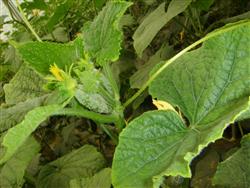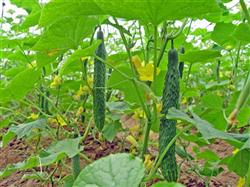Cucumber cultivation techniques: which diseases should be controlled in cucumber planting?

Which diseases should be controlled in cucumber planting? Also ask friends to help introduce the cucumber in the planting process, the main diseases that will occur are downy mildew, powdery mildew, blight, bacterial angular spot; the following is a detailed introduction and control methods of these diseases (for your reference). First, the harm of cucumber downy mildew: downy mildew disease caused by fungal infection. The disease will occur during the whole growth period. after the seedling disease, the cotyledons appear irregular yellowing phenomenon. in the true leaf stage, there are mostly water-immersed spots on the leaf margin or local leaves, and soon change from yellowish green to yellow spots. Under wet conditions, a black mildew layer is produced on the back of the leaves. When seriously ill, the leaves dry up. The main causes of the disease are high air humidity and large temperature difference between day and night. Control methods of cucumber downy mildew: method 1. Select disease-resistant varieties. Method 2. Take water control as the center, cultivate strong seedlings and increase the application of phosphorus and potassium fertilizer. Method 3. Spray with 800 times liquid of 25% Ruidotoxin wettable powder, 600 times liquid of 75% chlorothalonil, 500 times liquid of 65% mancozeb, 500 times liquid of mancozeb wettable powder, fumigation with 45% chlorothalonil aerosol, 250 grams per mu. Second, the harm of cucumber powdery mildew: the disease caused by fungal infection. The disease, commonly known as "white hair", occurs from seedlings to the whole growth period, and occurs in leaves, petioles and stems. During the onset of the disease, small white powder spots first appeared on the leaf surface, which gradually expanded and connected to each other into irregular large powder spots, and when the disease was serious, the back of the leaf was also covered with white powder. The cause of cucumber powdery mildew: high temperature, high humidity and high temperature and drought conditions appeared alternately. Control methods of cucumber powdery mildew: method 1. Select resistant varieties. Method 2. Strengthen the management of intertillage, cultivate strong seedlings, increase the application of phosphorus and potassium fertilizer, timely and appropriate amount of water, reasonable close planting. Method 3. Remove the old and diseased leaves in time to improve ventilation and light transmission. Method 4. Control with 15% trimethoprim 1500 times solution, 75% chlorothalonil wettable powder solution and 50% sulfur suspension 200 times solution. Third, the harm of cucumber blight: cucumber blight caused by fungal infection. Infection is possible at all stages and in all parts of the plant. The disease part showed dark green water immersion, soft rot, constriction, and the organs above the affected part withered and withered. After the fruit is damaged, it is soft rotten, and appears white frost, accompanied by fishy smell. Cucumber causes: 1, spread by wind and rain, more rain, early rain, early onset. 2. The disease is serious in the land with clay and poor drainage. 3. Apply the last rotten farm manure. Cucumber control methods: 1. Strengthen cultivation and management, select plots with good drainage, avoid flood irrigation, apply mature farm manure, and increase phosphorus and potassium fertilizer. 2. At the initial stage of the disease, use 25% metalaxyl wettable powder 800 Rue 1000 times solution; 58% metalaxyl manganese zinc 500x solution, 75% chlorothalonil 600x solution, 64% disinfectant alum 500x solution; you can use 25% Ruodui and 54% Fumishuang wettable powder mixed with 500x solution at 1:1, 0.25-0.5kg per plant. Fourth, the harm of cucumber bacterial angular spot disease caused by bacterial infection in cucumber. Both the leaf and the fruit can be harmed, the cotyledons show water-immersed near-round concave spots, gradually change to yellowish brown, the real leaves show light green water-immersed spots after being infected, and then polygonal macula is formed due to the limitation of leaf veins, and the periphery of the disease spot is flooded when wet. And produce bacterial pus. The disease spot is withered and perforated when it is dry. Causes of bacterial angular spot of cucumber: 1. Seeds, wind and rain, irrigation, insects and farm tools can be the vectors to spread the disease. 2. Low temperature, high humidity or damp and rainy are the main conditions of the disease. Control methods of bacterial angular spot of cucumber: 1. Strengthen cultivation and management and implement crop rotation. 2. The seeds were soaked in 50-55 ℃ warm soup for 20 minutes, streptomycin sulfate 3 million units for 2 hours, or agricultural streptomycin 200PPM for 30 minutes. 3. Timely removal of diseased leaf residues, control of watering, ventilation and dehumidification are beneficial to reduce the disease. 4. Use 25% Reduscum 600 Mill 800 times, agricultural streptomycin 4000 Mel 5000 times solution, neoptomycin 150-200PPM spray to prevent and cure. Click to get more cucumber cultivation techniques click to get more vegetable planting techniques
- Prev

Cucumber cultivation techniques: what is cucumber flower topping?
What is the topping of cucumber flowers? What harm does cucumber flower top have? Also ask experienced netizens to help introduce and guide the harm of cucumber flower topping and prevention methods can refer to the following list. The cause and harm of cucumber flower topping: cucumber is very easy to grow in early spring, late autumn or winter if it is not managed properly.
- Next

Cucumber cultivation techniques: how to top fertilize cucumber planting?
How to top fertilize cucumber planting? There are no netizens to introduce the method of cucumber planting in order to obtain high yield, it is necessary to top fertilizer according to the characteristics of cucumber fertilizer, the following methods of cucumber topdressing are introduced for your reference: method 1, fertilization method before planting to set melon: soil temperature in the early growth stage of cucumber (generally within one month after planting).
Related
- Where is it suitable to grow horseradish in China? it is expected to see the middle altitude horseradish in Alishan.
- How to prevent tomato virus disease reasonably? (Control methods included)
- Many people like to plant towel gourd on the balcony. What are the main points of this method and management?
- What crops can chili peppers be mixed with?
- Fertilization techniques and matters needing attention in Tomato
- What are the grafting techniques for peach seedlings in spring?
- Harm and control methods of root swelling disease of Chinese cabbage
- What are the pests of sweet potatoes? How to prevent and cure it?
- Symptoms, causes and Control methods of navel Rot in Tomato
- The cause of "Cucumber rotten bibcock" in Farmers' planting Cucumber and its Control Plan

